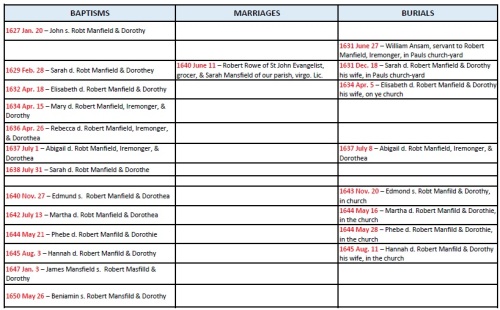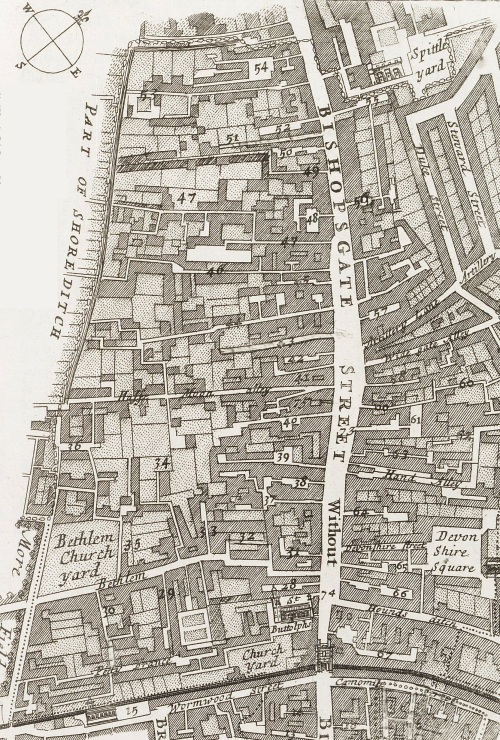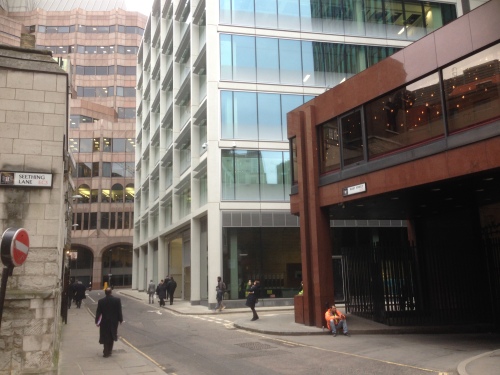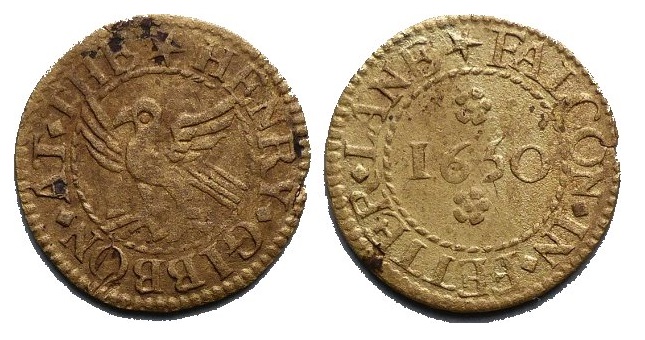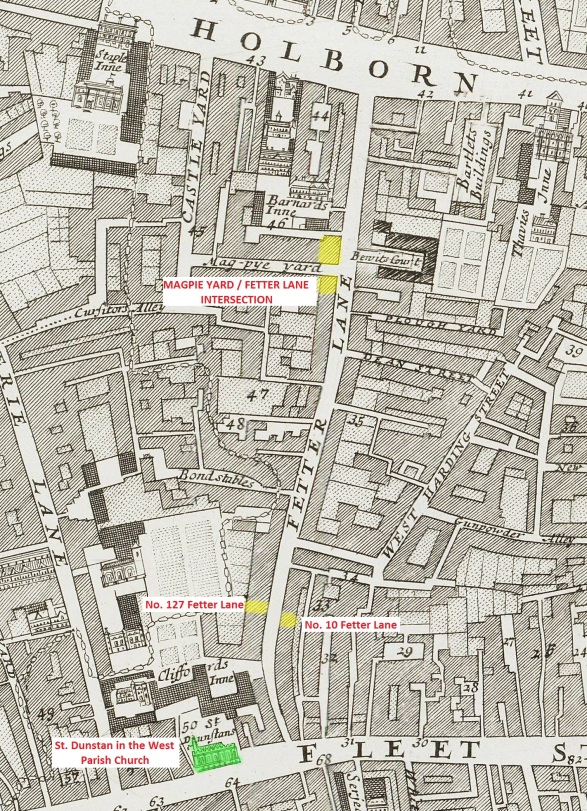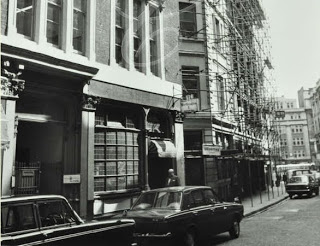The above copper half penny token measures 20.9 mm and weighs 1.34 grams. It was issued by a tradesman operating from Duke’s Place in London in the mid-17th century. Its design may be formally described as follows;
Obverse: (mullet) IOHN . EMPSON . 1667 . , around the depiction of crown or coronet above a fire beacon. A banner across the latter bears the motto NISI DOMINUS.
Reverse: (sexfoil) IN (cinquefoil) (cinquefoil) PLACE, around a twisted wire inner circle. A in three lines reads HIS / HALFE / PENY below a triad of initials reads, I| F.|A .
The token’s issue date of 1667 is clearly stated in its obverse along with the name of its issuer, John Empson. The triad of initials on the token’s reverse are those of the token issuer and his wife, whose christian name began with the letter “A”. The token’s reverse also states the location of John Empson’s business, i.e. Duke’s Place in the Aldgate Ward of the city. At the beginning of the 17th century this area comprised a mixture of late 16th century buildings scattered within the partial remaining structures of the former Priory of Holy Trinity, Christ Church which previously occupied the site. After the dissolution of the priory, in 1531, King Henry VIII gave it to Sir Thomas Audley. It subsequently passed to his son-in-law, the 4th Duke of Norfolk, from whom the name “Duke’s Place” is derived.
The pictorial image on the token’s obverse (i.e. a coronet above a fire beacon) is almost certainly a depiction of the trade sign which hung over its issuer’s (or a neighbour’s) business premises. If it was his personal trade sign, and not just one which had long been associated with the building he operated from, its design may well offer clues as to his trade/profession. The sign of a fire beacon is not at all common and combined with a coronet it is believed to be unique, at least in London. Examples of a beacon, as used for a 17th century London trade sign, are known for both a distillers and a tavern. Both of these examples are from Southwark(1) . In the case of the tavern, which took its name from a nearby fire beacon, its proprietor is also known to have issued his own trade tokens(2) .
The Latin motto (i.e. Nisi Dominus(3) , which may be translated as “Except the Lord”) draped across the pictorial image on John Empson’s trade token is not so easy to explain (Note 1).
In Search of John Empson and his Family
Initial investigations indicated the existence of two separate individuals by the name of John Empson living in the parish of St. James, Dukes Place in the latter half of the 17th century. The first of these men died in 1681 while the second was still inhabiting the area during the early part of the 18th century. Despite their common surnames it appears the two individuals were totally unrelated. Subsequent research has indicated that it was the former of the two men who was responsible for the issue of the above token. The following brief history of this individual, and his immediate family, has been pieced together from a variety of contemporary sources including parish registers, livery company records, hearth tax returns and probate records.
The plan below is based on the Agas Map of London (c.1561) and shows some of the locations that are mentioned hereafter in the story of John Empson and his family.

Part of the Agas Map of London (c.1561) – Locations Shown: St. Peter le Poer Church (1); St. Henen’s Bishopsgate (2); Priory of Holy Trinity, i.e. Dukes’s Place (3); Perimeter of Aldgate Ward (4); St. Botolph’s Without, Aldgate (5); The Minories (6); St. Katherine Coleman (7); Future location of Swan Alley (8).
While it is not certain there is a possibility that the issuer of the above token can be identified with one John Empson who was baptised on 12th February 1608/9 in the parish of North Walsham in north east Norfolk (Note 2).
Around the age of seventeen (i.e. c.1625) it can be assumed young John, like so many other provincial young men of his age, was bound into a London apprenticeship by his father in order to learn a trade. Typically, such apprenticeships lasted for a period of seven years after which, assuming the apprentice had stayed the course, he would be eligible to become a freeman of his master’s associated livery company. Assuming John served an uninterrupted apprenticeship period it would be logical to assume he gained his freedom c.1632. The name and trade of John’s master is unknown but it is likely that he was a member of the Worshipful Company of Cordwainers, as by 1651 this was the trade by which John listed himself (see below).
On 29th November 1649 John Empson married Mary Mathews at the parish church of St. Peter le Poer in the Broad Street Ward of London. In 1651 the couple had a son as recorded in the parish registers of St. Helen’s Church, Bishopsgate.
“Edmond Empson son of John Empson cordwainer and his wife Mary was baptised this 18th day of May. A. D…………1651”
It is not clear where John Epsom and his family were living at this time but it was presumably within the parish of St. Helen’s, Bishopsgate (Note 3). The eastern boundary of this parish runs alongside the Aldgate Ward of the city and as such is in very close proximity to Duke’s Place, the location of John’s business premises as noted on his trade token issued in 1667.
Unfortunately, John and Mary’s son died only three months after his first birthday as recorded in the parish registers of St. Helen’s Church, Bishopsgate.
“Edmund Empson infant son of John Empson was buried in the churchyard the 25th day of August. A.D…….1652”
Between 1652 and the mid-1660s there appears to be no further reference to John Empson and his family despite the death of his first wife, Mary, and his subsequent re-marriage to his second wife, Ann. Despite extensive searches in both London and Middlesex parish registers the current writer has been unable to find any documentary references to either of these two key events in John Empson’s life. While both must have transpired during the period 1651 to 1667 (Note 4) their occurrences are only known from indirect references in later dated records. While the date and cause of death of Mary Empson remains unknown it is clear (as will be seen later) that she was buried in a grave in the south side of the churchyard of St. Helen’s Church, Bishopsgate.

The parish church of (Great) St. Helen’s Bishopsgate, London showing the now paved over ancient churchyard where the Empson family were buried.
The next documentary reference to John Empson occurs in the London Hearth Tax returns for Lady Day (i.e. 25th March) 1666. His name appears as one of the 249 property occupiers listed under the parish of St. James’, Duke’s Place. According to his entry in the returns he was then occupying a property having five hearths(4) . We can’t be certain if this property was serving as his family home or just his business premises but typically we might expect it to have represented both as it was common for tradesmen of the period to live either over and/or behind their place of work. The latter, if a shop or tavern, would normally face onto a thoroughfare for ease of public access and marketing of the tradesman’s goods.
We do not know if and how the Empson family were effected by either the Great Plague of 1665 or the Great Fire of September 1666. However, they were lucky in respects to the latter as neither of the adjacent locations in the city with which they appear to have then been associated (i.e. the parishes of St. Helen’s, Bishopsgate and St. James’, Duke’s Place) were greatly affected by the devastating fire which consumed 83% of the city within just a few days.
From 1667 until 1679 John Empson and his family again appear to fall off the historical radar with no contemporary references to them being known. Then in 1680 John reappears in, of all places, the records of the Worshipful Company of Innholders.
At some time after 1651, when John Empson was recorded as a cordwainer and prior to 1680, he appears to have changed his profession and become a member of the Innholders Company. This is apparent as on 3rd May 1680 the latter Company’s records list him as taking on an apprentice, one Robert Holkey or Holby/Holbie (Note 5), the son of Henry, a woollen draper from Aylsham(5) . Based on evidence presented hereafter it would appear that Robert was one of John’s cousins from Norfolk and hailed from a neighbouring parish to where John is believed to have been born in 1608/9.
While the surviving apprentice registers for the Innholders Company are not totally complete sufficient remain to conclude that Robert Holby/Holkey was the first apprentice John had taken on since becoming a member of the Company(6) . This begs the questions of how long had John been in the trade and what exactly attracted him into it? The number of hearths recorded in his Hearth Tax return for 1666 (i.e. five) does not imply he was then occupying an inn which one might expect to have far more hearths associated with it. One possible explanation is that John entered his new trade through a business inheritance which came via his second wife Ann.
One potential reason for John Empson taking on an apprentice at this time could be related to his age and the reduced ability for him and his wife to carry on managing their business effectively, presumably with only domestic servants to rely on as back-up. If John Empson the token issuer was one and the same person as the individual baptised in North Walsham in 1608/9 then by 1680 he would have been 71 years old and presumably thinking of retirement. Unfortunately, events were to overtake John and just over a year later it appears his health was failing him.
On 2nd August 1681 John Empson made his last Will and Testament (7) in which he described himself a citizen of London and Innholder. Three weeks later John was dead. His burial is recorded in two of his local parish churches St. Botolph’s Without, Aldgate, and St. Helen’s Bishopsgate where his body was interred. Firstly, from the parish registers of St. Botolph’s, Aldgate we learn that;
“24th August 1681 – John Empson, Innholder, buried at St. Hellen’s.”
The burial register entry from St. Helen’s, Bishopsgate is more informative and even confirms the burial location of his first wife, Mary.
“John Empson was buried in the Churchyard on the South side in his first wife’s grave the 24th day of August 1681.”
According to the provisions of John’s Will he was to be buried in the churchyard of St. Hellen’s Bishopgate. His wife, Ann, was made executrix of his Will and was to inherit his estate after payment of any outstanding debts and funeral expenses plus the following set of bequests(8) ;
- To James Empson, his brother in North Walsham. – Twelve pence.
- To Katherine Roys – His best bed with green curtains and valance and all things associated unto.
- To Henry Mathews his son in law (Note 6) – The deeds and ownership of the house in which Henry currently lived (which presumably was owned by John).
- To each of the children of Henry Mathews – Four pounds.
- To Israel Turant (his servant) – Forty shillings.
- To Elizabeth Kempe (the daughter of Joan Kempe) – Twenty shillings.
- To the widow of Captain Philip Starky (Note 7) – Ten pounds
- To each of his cousins; Thomas, John, Joseph, Robert and John Holkie/Holby the younger of Norwich, Norfolk) – A small gold mourning ring.
- Thomas Berry, the son of John Berry of Aylesham, Norfolk – A small gold mourning ring.
- Moses Roys of White Friars, London – Thirty shillings.
- William Carter, cordwainer of London – Thirty shillings.
By a request in his Will John Empson also charged his good friends Moses Roys and William Carter to act in assistance to Ann in executing the terms of his Will(9) .
As an aside, an inventory dated 30th September 1861, of the contents of John Empson’s London home (10) is appended to the probate copy of his Will (Note 8). Apart from giving us a glimpse of the Empson family’s living conditions and household goods this inventory is interesting in several other respects. Firstly, its opening lines indicates its location as being within the parish of St. Botolph’s Without, Aldgate. This is a neighbouring but separate parish to St. James’, Duke’s Place where the Empson’s were living in 1666 and 1667. The property described in the inventory would also suggest that if John Empson was still an acting innholder at the time of his death, as suggested by statements in both his Will and the inventory, he was living in a separate and much smaller dwelling to that of a typical 17th century inn. This might suggest he was the acting manager rather than the proprietor of whichever inn he was associated with at the time of his death.
After John’s death his widow Ann appears to have retained strong ties with his cousin and once apprentice Robert Holby. By the late 1680s Robert was living in the parish of St. Mary’s, Whitechapel. He stated profession at that time being a Glover (Note 8)(11) .
After John’s death Ann Empson is known to have had two properties in Swan Alley, in the Minories district of the parish of St. Botolph Without, Aldgate. These she leased off the Master of the Bridge House (i.e. the warden of London Bridge)(12) . It is possible that one of these properties was that detailed in the household inventory attached to the probate copy of John Empson’s Will.

The Minories district of St. Botolph’s Without. Aldgates showing the location of Swan Alley (c.1720).
In the third quarter of the 1680s Ann Empson was living in Middlesex in a leased property located in Blewgate (or Blue Gate) Fields in the hamlet of Wapping in the parish of St. Dunstan’s, Stepney. This she leased off one Robert Hasting, Esquire(13) .
By this time Ann’s health was obviously faltering as she made her Last Will and Testament on 16th September 1687(14) . Just over a year later in January 1688/9 she died. Her death is recorded in her local parish registers of St. Dunstan and All Saints, Stepney.
“6th January 1688 – Ann Empson of Wapping, widow (buried) at St. Hellens, London.”
By the terms of her Will Ann requested “to be decently interred in the churchyard of the parish of Great St. Helens, London, in or near the place where my late husband was buried.” In accordance with this request her burial is further recorded in the parish registers of St. Helen’s, Bishopsgate.
“Ann Empson of the parish of Stepney was buried in the churchyard – 7th January 1688”
Ann made Robert Holby, her “loving Kinsman”, the executor of her Will as well as its principal beneficiary. Robert was to inherit the bulk of her estate after payment of any outstanding debts and funeral expenses and after the following specific bequests had been made(15) ;
- Robert Holby – Her lease hold properties in both the Minories and Blue Gate Fields.
- Richard Roys (her kinsman (Note 9) and the son of Moses Roys) – Twelve pence.
- To whom ever stripped, laid out her body prior to burial – All her cloths, linen and woollen garments.

The signatures of John (left) and Ann (right) Empson respectively taken from their last Will and Testaments.
Notes:
- John Empson and his immediate family had various trade associations throughout their history in the city. These included links to the Worshipful Companies of Cordwainers, Innholders plus possibly the Glovers and Leathersellers Companies also. None of the mottos of these Livery Companies match that on John’s token. As such its significance in this case remains an enigma.
- This individual was the son of a John Empson and his wife (who was possibly named Alice) of North Walsham, Norfolk. In addition to John Empson junior this individual had at least a further three children. Namely, Amphilius (baptised in North Walsham on 11th March 1609/10), William (baptised in North Walsham on 1st March 1611/2) and James (baptism date and location unknown).
- The parish church of St. Helen’s, Bishopsgate formed the nucleus of the former Benedictine convent based on the site. In 1543 the Worshipful Company of Leathersellers acquired the site where they set-up their new Hall. Thereafter the area and the parish church itself retained close associations with this Livery Company. Given that for a significant part of his working life John Empson’s was a cordwainer it may not be by accident that he chose to live in this part of the city.
- The last documentary mention of Mary Empson is the baptism record for her and John’s son which is dated 1651. The first historic reference to John’s second wife, Ann, is found in the numismatic record in 1667. This takes the form of the letter “A” in the triad of issuer’s initials on the reverse side of his trade token issued in that same year.
- The published form of Robert’s surname in Volume 17 of London Apprentices is in fact “Holkey”(16) and not “Holbey”. However, the current writer is of the opinion that the published form of the name is a transcription error of the Livery Company’s original 17th It appears that this same individual is mentioned in several later dated documents related to the Empson family(17)(18) . In these he is variously described as being one of John Empson’s cousins from Norfolk or a kinsman of Ann Empson. In these later documents his name is variously spelt “Robart Holbie” or “Robert Holbey”.
- In this case the term “son-in-law” can almost certainly be translated into the more modern equivalent term “step-son”. This implying that when John married Mary Mathews she was likely a widow with at least one surviving child (i.e. Henry) from a previous marriage.
- The lady here being referred to is likely to Mary Starky or Starkey who, by the date John Empson’s Will was written in 1681, was a widow. The name of Captain Philip Starkey is of some potential historical interest. A person having that same name and title, which can be of no coincidence, lived in London during the 17th century and is known to have been buried in the parish church of St. Katherine Coleman in 1679. Philip Starkey was a cook of London Wall and was master of the Worshipful Company of Cooks for 1688 to1689. During the Commonwealth period he was employed as a master cook to the household of the Lord Protector, Oliver Cromwell. He also officiated at several state banquets organized by Cromwell for foreign ambassadors for which he charged a fee of £20(19) . At the time of his death he was Captain of the Red Company of the London trainedband(20) .
- An inventory of John Empson’s home at the time of his death in 1681. This dwelling was located in the parish of St. Botolph Without, Aldgate, possibly in Swan Alley off the Minories.

- Although inferred in Ann’s Will (of 1687) the family relationships between herself and Richard and Moses Roys are not yet known. Moses and a Katherine Roys are also mentioned in John Empson’s Will (of 1681) in which Moses is described as John’s “loving friend” of White Fryers, London. The family of a Moses and Katherine Roys are variously recorded in the parish registers of St. Dustan in the West along with St. Bride’s, Fleet Street, London in the 1680s. Prior to this, in the 1670s, the family of a Moses and Mary Roys are recorded in the parish of St. Andrew’s, Holborn. It is possible that both family units are based on the same Moses Roys who could have re-married Katherine after the death of Mary. Either way as yet no records have been found relating to a Richard Roys being the product of either marriage, although it appears likely that he was. One hypothesis is that Moses Roys was the brother of Ann Empson which by birth would make her Ann Roys. Unfortunately such a family connection can’t yet be proven although records have been found of a William and Ann Roys being born to a William and Joan Roys of the Liberty of Norton Folgate, London in 1628 and 1629 respectively.
References:
- Lillywhite, B. – London Signs: A Reference Book of London Signs from Earliest Times to about the Mid Nineteenth Century. (London, 1972).
- Everson, T. – Seventeenth Century Trading Tokens of Surrey and Southwark. (Llanfyllin, 2015).
- G.C. – Trade Tokens Issued in the Seventeenth Century in England, Wales and Ireland by Corporations, Merchants, Tradesmen, Etc. – A New and Revised Edition of William Boyne’s Work. Volume 2. (London, 1967).
- Davies, M.; Ferguson, C.; Harding, V.; Parkinson, E. & Wareham, A. – London and Middlesex Hearth Tax. The British Record Society. Hearth Tax Series Volume IX, Part II. (London, 2014).
- Webb, C. – Innholders’ Company 1642-1643, 1654-1670, 1673-1800. London Livery Company Apprenticeship Registers. Volume 17. (Society of Genealogists, London. 1998).
- Ibid 5.
- Reference Number: MS 9052/22. Will Number: 19. London Metropolitan Archives and Guildhall Library Manuscripts Section, Clerkenwell, London.
- Ibid 7.
- Ibid 7
- Ibid 7.
- Reference Number: MS 90172/77. Will Number: 2. London Metropolitan Archives and Guildhall Library Manuscripts Section, Clerkenwell, London.
- Ibid 11.
- Ibid 11.
- Ibid 11.
- Ibid 11.
- Ibid 5.
- Ibid 7.
- Ibid 11.
- Latham, R.C. – The Diary of Samuel Pepys. Volume 10 – Companion. (London, 1995).
- Ibid 19.








